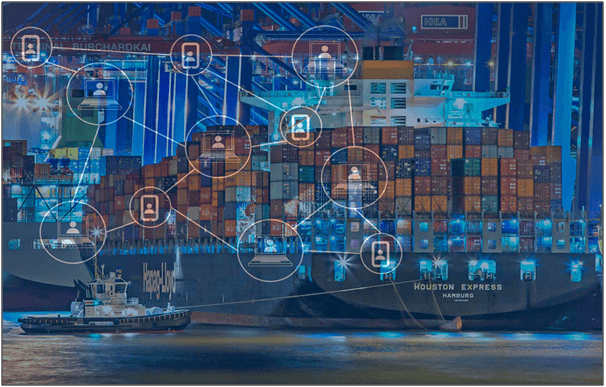The landscape of maritime is shifting with the trends that are emerging do so out necessarily. Smart shipping, shipbuilding, big data, propulsion, advanced materials and analytics, sensors, robotics and communications in conjunction are all having monumental shifts in maritime industry are approaching new challenges and opportunities.
Table of Contents
Cyber-Security
In 2017, cyber-attacks showed vulnerability in navigate and other information systems on ships and in ports. thus far international cybersecurity rules for the maritime industry haven’t yet been adopted. Meantime, the IMO guidelines on managing cybersecurity risks high-level recommendations regarding the protection of international shipping from existing and potential threats to cybersecurity. These guidelines can help to extend protection of international shipping to cybersecurity.
IMO principles included five functional elements for effective risk within the maritime industry: identify,detect,protect, respond and recover. For efficiency these elements should be included altogether with the operations of the company and personnel management.Currently, safety culture issues are being developed within the framework of the International Safety Management (ISM) Code.
The main purpose of the ISM Code is to form a world standard for the safe management and operation of ships and thus the prevention of environmental pollution. It establishes the safety management objectives, also as prescribes that the shipowner or the opposite authorized person (for example, a bareboat charterer or operator who accepts responsibility for operating the vessel) creates a security management system and establishes the suitable policy to understand safety objectives.

Internet of Things (IoT)
The Internet of Things technology (IoT) is additionally a network of connected devices with unique identifiers within the kind of Internet protocol addresses, with embedded technologies or equipped with technologies that allow them to perceiving, collect data and report on the environment during which they’re located and / or on themselves . Within the shipping industry, IoT getting accustomed support informed decision-making on route optimization, object tracking and maintenance of mechanisms . Applications which can be applied during this area include, as an example , a program that uses satellite data to figure out the foremost efficient route and ships ETA within the important time, also due to the foremost recent intelligent containers that use sensors, and telemechanics to trace indicators of temperature, vibration, humidity, and air quality during maritime transport.
IoT is increasingly getting used within the all industry to boost communication between ship and shore intelligent traffic management. A far better interface between ships and ports include, for example , analyzing large databases to reduce shipping time and time spent entering ships in ports and other areas with heavy traffic, thereby reducing port congestion. As an example , the cooperation initiative within the sphere of digitization between the Port of Rotterdam and IBM should the preparation of this port for the further adoption of vessels that are up to 42 km away to increase the protection and efficiency of the port. Other applications of IoT is remote of ships without human intervention. As soon because it becomes possible to repair ships, ‘ waste in real time, it’ll be possible to optimize operations using the blockchain technology.

Blockchain Technology
Blockchain may be a distributed registry technology that permits you to securely record transactions within the registry in several places at an equivalent time and through several individuals without the necessity to involve the central administration or intermediaries. The potential problems related to the maritime industry digital innovation. That is the lack of standardization of electronic data interchange.
Therefore, the need for a standard format for the exchange of data.Electronic data interchange involves the electronic transfer of economic or administrative transactions from one computer to another, using an standard for structuring these operations or messages.This disadvantage, alongside the overall uncertainty regarding the potential applications of the blockchain.
In general, the blockchain has the potential to extend the safety of the web of Things. Using the blockchain technology, for instance, you’ll secure documents, block theft of private data, use public-key cryptography, and stop unauthorized access to data, unlike the method of signing documents in paper form, and other sorts of electronic data interchange. This technology is additionally designed to reinforce cybersecurity by removing the sole target that a hacker can attack to endanger the whole system. Thus, granting permission to manage data using the blockchain may include adding a level of security and gradually reducing the scope of centralized data storage and processing.

Fire Fighting Robots
Many industries around the world including shipping companies have recognized robots significance and began showing much interest on their usage. It’s efficiency while simultaneously cutting cost and mitigating safety concerns. One such introduction that has attracted everyone’s attention would be the Shipboard Autonomous Fire Fighting Robots (SAFFiR) created by the Naval lab together with the Virginia Tech and other US universities. The target of SAFFiR is to develop a human-centric autonomous system that helps to extinguish fires at the first stages before they become catastrophic.
At present, Shipboard Autonomous Fire Fighting Robots can walk towards a sailor, stop, turn, locate the warmth source of a fireplace behind a door and take a hose once the door opened and blast the flames with water, without falling or stopping. The futuristic autonomous firefighting humanoid robot concept is to assist human fire fighters and not replace them in firefighting operations and completing inspections on board the vessels. It’s still within the developing phase but poised to be an efficient solution to fires on board once the modifications are concluded for seamless movements round the curves and edges of the ship. Aim is to realize a far better walking and wall crawling spider SAFFiR to fight fires.
The full content is only visible to SIPMM members
Already a member? Please Login to continue reading.
References
Bavani Prapaharan, ADLSM. (2017). “New Technologies in the Maritime Industry”. Retrieved from SIPMM: https://publication.sipmm.edu.sg/new-technologies-maritime-industry/, accessed 18/06/2020.
Patrick Prinston. (2018). “Top 4 Trending Technologies In The Maritime Industry”. Retrieved from https://www.searates.com/blog/post/it-technologies-in-the-marine-industry, accessed 18/06/2020.
Wong Kam Foo, DLSM. (2020). “Technologies for Improving Logistics Productivity”. Retrieved from SIPMM: https://publication.sipmm.edu.sg/technologies-improving-logistics-productivity/, accessed 18/06/2020.

